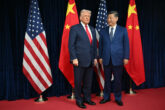December 07, 2023
Resisting China’s Gray Zone Military Pressure on Taiwan
Introduction
The People’s Republic of China (PRC or China) has sharply escalated its pressure campaign targeting the Republic of China (ROC or Taiwan) in recent years. Beijing appears likely to use Taiwan’s upcoming presidential election in January 2024 as a pretext to apply more pressure on the self-governing island, particularly in the “gray zone” using China’s military, the People’s Liberation Army (PLA), along with other tools of state power. There is no precise and commonly agreed upon definition of what gray zone activities are and are not. In general, though, the concept refers to actions that fall into the space between, on one side, peace and, on the other, full-scale kinetic war.1 Gray zone activities are coercive and aggressive but designed to stay below the threshold of triggering major conflict.
China uses gray zone operations as part of a comprehensive strategy to pressure Taiwan that spans the areas of diplomacy, information, economics, and security. This policy brief examines one major component of that campaign: gray zone military and security operations. It starts by detailing the capabilities and tactics China uses to put security pressure on Taiwan. Then, it explains what Beijing seeks to achieve with those actions. The paper concludes with recommendations for how U.S. and Taiwan policymakers can resist and counter China’s gray zone operations.
PRC Gray Zone Military Pressure Targeting Taiwan
China uses a variety of PLA capabilities to exert gray zone pressure on Taiwan. These include crewed air patrols into Taiwan’s air defense identification zone (ADIZ). Frequent sorties started in 2020 and spiked in August 2022 after the visit of then–U.S. House Speaker Nancy Pelosi to Taiwan.2 Taiwan’s Ministry of National Defense said that in September 2023, PLA flights in Taiwan’s vicinity hit a new record of 103 sorties in a single day, 40 of which entered Taiwan’s ADIZ or crossed the median line in the middle of the Taiwan Strait.3
Incursions now feature a wider variety of aircraft flying different routes, including more circumnavigations completely around Taiwan and crossings of the median line. The latter practice has obliterated an operational norm that helped maintain cross-Strait peace and stability for decades.4 Moreover, until August 2022, most PLA sorties flew through the southwest corner of Taiwan’s ADIZ closer to Dongsha (Pratas) Island in the South China Sea rather than the more provocative routes near Taiwan’s main island that the PLA often flies now.
Beijing has also upped military pressure using uncrewed aerial vehicles (UAVs). In September 2022, the PLA flew a UAV across the median line for the first time.5 The same month, Taiwan’s troops shot down a civilian PRC drone that was flying over Kinmen Island, which is controlled by Taiwan but sits right off China’s coastline.6 In April, a PLA combat drone made the first publicly reported flight completely around Taiwan within its ADIZ.7 China has also flown surveillance balloons near Taiwan that are similar to the one that flew over the United States in February 2023.8
At sea, PLA Navy (PLAN) vessels spend more time closer to Taiwan compared with previous years. PLAN forces contest U.S. support for Taiwan and assert Beijing’s claim that “China has sovereignty, sovereign rights, and jurisdiction over the Taiwan Strait” through deliberately unsafe and unprofessional operations near American and allied military assets.9 In June, a PLAN warship cut across the bow and came within 150 yards of the U.S. guided missile destroyer USS Chung-Hoon (DDG 93) while the latter transited the Taiwan Strait along with the Canadian frigate HMCS Montreal.10 Beijing further employs marine survey vessels and hydrographic survey ships to operate near Taiwan.11
Incursions now feature a wider variety of aircraft flying different routes, including more circumnavigations completely around Taiwan and crossings of the median line.
China also conducts large-scale military exercises in Taiwan’s vicinity, including more drills east of Taiwan in recent years. Many of those exercises take place in international waters and do not, in isolation, necessarily contravene international laws and norms any more than U.S. and allied exercises in equivalent locations. Taken in context, however, they contribute to a comprehensive pressure campaign to intimidate Taiwan. Official sources said China’s first domestically built aircraft carrier, Shandong, practiced operating in the Western Pacific in April and September to surround Taiwan, “cutting down potential escape routes of ‘Taiwan independence’ secessionist forces and keeping external interference forces at bay.”12 During the September cruise, the group led by the Shandong sailed south of Taiwan and then met up with another PLAN flotilla that had sailed around Taiwan’s north. Together, they conducted China’s largest-ever aircraft carrier exercises in the Western Pacific.13
Such PLA exercises often include China declaring no-sail and no-fly zones in their areas of operations that can force commercial traffic to reroute. Missile launches as part of those drills are especially threatening and have been a feature of major crises, most recently in August 2022 when China fired 11 ballistic missiles toward Taiwan. In a first, four of those missiles flew directly over Taiwan, albeit at a very high altitude.14
Finally, in the future, China could start to use military (and paramilitary) gray zone tactics that Beijing has employed elsewhere, such as the South China Sea, but that have not yet been common features of gray zone pressure against Taiwan. These include locking targeting radar on military assets, using lasers to blind operators, and conducting dangerous maneuvers and even ramming operations against aircraft and ships while using combinations of PLAN, China Coast Guard, and paramilitary maritime militia forces.
Download the Full Report
- For a theoretical assessment of “gray zone” activities and related concepts, see Michael Mazarr, Mastering the Gray Zone: Understanding a Changing Era of Conflict (U.S. Army War College Press, 2015), https://press.armywarcollege.edu/monographs/428/; Michael Green et al., “Deterrence Theory and Gray Zone Strategies,” in Countering Coercion in Maritime Asia: The Theory and Practice of Gray Zone Deterrence (Center for Strategic and International Studies, May 2017), https://csis-website-prod.s3.amazonaws.com/s3fs-public/publication/170505_GreenM_CounteringCoercionAsia_Web.pdf. ↩
- "Taiwan ADIZ Violations" (ROC Ministry of National Defense data as compiled by Gerald C. Brown, Ben Lewis, and Alex Kung; accessed September 2023), https://docs.google.com/spreadsheets/d/1qbfYF0VgDBJoFZN5elpZwNTiKZ4nvCUcs5a7oYwm52g/htmlview. ↩
- Republic of China Ministry of National Defense (@MoNDefense), “103 PLA aircraft and 9 PLAN vessels around Taiwan were detected by 6 a.m. (UTC+8) today. R.O.C. Armed Forces have monitored the situation and tasked CAP aircraft, Navy vessels, and land-based missile systems to respond these activities.” X (formerly Twitter), September 17, 2023, https://twitter.com/MoNDefense/status/1703615924069446015. ↩
- Thomas Shattuck, “The PLA Air Force Erases the Taiwan Strait Centerline,” Global Taiwan Institute, September 7, 2022, https://globaltaiwan.org/2022/09/the-pla-air-force-erases-the-taiwan-strait-centerline/. ↩
- Minnie Chan, “Taiwanese Military Confirms for First Time PLA Drones Crossed Taiwan Strait Median Line,” South China Morning Post, September 11, 2022, https://www.scmp.com/news/china/military/article/3192126/taiwanese-military-confirms-first-time-pla-drones-crossed. ↩
- Lily Kuo and Vic Chiang, “Taiwan Shoots Down Civilian Drone as Tensions with China Simmer,” The Washington Post, September 1, 2022, https://www.washingtonpost.com/world/2022/09/01/taiwan-drone-china-tensions/. ↩
- Karen Hao, “Chinese Warships and Planes Test Taiwan Defenses,” The Wall Street Journal, April 28, 2023, https://www.wsj.com/articles/chinese-combat-drone-circles-taiwan-in-mass-incursion-44116201. ↩
- Gordon Corera, “New Images Show Chinese Spy Balloons Over Asia,” BBC, June 26, 2023, https://www.bbc.com/news/world-65972168; Taiwan Ministry of National Defense, ROC National Defense Report 2023 (September 2023), 41, https://www.ustaiwandefense.com/tdnswp/wp-content/uploads/2023/09/Taiwan-National-Defense-Report-2023.pdf. ↩
- Ministry of Foreign Affairs of the People’s Republic of China, “Foreign Ministry Spokesperson Wang Wenbin’s Regular Press Conference,” June 13, 2022, https://www.fmprc.gov.cn/mfa_eng/xwfw_665399/s2510_665401/2511_665403/202206/t20220613_10702460.html; “China Raises Stakes with Broad Claim to the Taiwan Strait,” The Maritime Executive, June 13, 2022, https://maritime-executive.com/article/china-raises-stakes-with-broad-claim-to-the-the-taiwan-strait. ↩
- U.S. Indo-Pacific Command Public Affairs, “USINDOPACOM Statement on Unsafe Maritime Interaction,” June 3, 2023, https://www.pacom.mil/Media/News/News-Article-View/Article/3415952/usindopacom-statement-on-unsafe-maritime-interaction/; Sam LaGrone, “VIDEO: Chinese Warship Harasses U.S. Destroyer in Taiwan Strait Transit,” USNI News, June 4, 2023, https://news.usni.org/2023/06/03/u-s-canadian-warships-transit-taiwan-strait. ↩
- Taiwan Ministry of National Defense, ROC National Defense Report 2023, 41. ↩
- Liu Xuanzun, “China’s Aircraft Carrier Shandong Sails Past Taiwan Island for Second Far Sea Drill of the Year, Two Days after U.S. and Canadian Warships’ Provocative Straits Transit,” China Military via the Global Times, September 12, 2023, http://eng.chinamil.com.cn/CHINA_209163/TopStories_209189/16251587.html. ↩
- Kathrin Hille, “China’s Navy Starts Largest-Ever Exercises in Pacific Ocean,” Financial Times, September 12, 2023, https://www.ft.com/content/88e2eeab-e464-4ec3-a17f-5417150c5350. ↩
- “U.S. ‘Must Contest’ Chinese Missiles over Taiwan, Says Admiral,” BBC, August 16, 2022, https://www.bbc.com/news/world-asia-62560527. ↩
More from CNAS
-
Indo-Pacific Security / Energy, Economics & Security
How to Win the Economic War with ChinaTrump's approach to China has run aground, giving Beijing unprecedented advantage in the economic conflict....
By Edward Fishman & Julian Gewirtz
-
America’s Self-Loathing Is a Losing Hand
This article was originally published in The Washington Post.Around 10 years ago, the United States began a historic shift in its grand strategy toward China, abandoning the b...
By David Feith
-
Indo-Pacific Security / Energy, Economics & Security / Technology & National Security
Selling AI Chips Won’t Keep China Hooked on U.S. TechnologyU.S. policy should not rest on the illusion that selling chips can trap China inside the American tech ecosystem....
By Janet Egan
-
Will New Delhi-Beijing Move Beyond Friction Points? | Ex-White Official On India-China Reset
Prime Minister Narendra Modi on Friday said that India and China, as two major economies, must work together to bring stability to the global economic order. NDTV's Gaurie Dwi...
By Lisa Curtis





